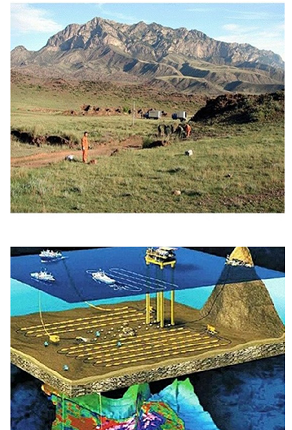Seismic data processing technology
Complex surface processing technology for terrestrial land
It can effectively solve the static correction problem caused by complex surfaces such as mountains, deserts and loess mounds, and improve the quality of imaging.
- Refractive wave chromatography static correction
- Static correction of rotary wave lamina
- Residual static correction of reflected waves
High-fidelity noise suppression technology can effectively improve the signal-to-noise ratio of data and provide a good data foundation for high-precision imaging of seismic data. The current technology can be widely used in many exploration areas at home and abroad, especially in the improvement of seismic data imaging effects in complex surface and low signal-to-noise ratio areas such as the western desert, mountainous areas and loess mounds in China.
- Linear noise suppression such as surface waves of irregular survey
- Curved wave transformation surface wave suppression
- Cross-arranged domain 3D FKK surface wave suppression
Based on the real coordinate position and the 5D regularization and interpolation technology, the 5D regularization and interpolation technology adopts Fourier reconstruction technology to realize the regularization of seismic data, which can regularize irregular seismic data to the center point of the grid, and can also intensify the sparse space sampling seismic data.
Offshore broadband processing technology
The offshore bubble suppression technology and ghost wave suppression technology can optimize the processing of low-frequency information, so as to effectively widen the frequency band, improve resolution, and improve the imaging quality of medium and deep data.
- Bubble pressing technology
- Shot point ghost wave suppression technology
- Offshore multiple suppression technology
Data-driven shallow water multiplexing techniques that do not rely on a single wave are essential to improve the vertical resolution of data. At the same time, for the ocean data of different water depths, the multiple waves related to the seabed are also abnormally developed, and the multiple wave suppression technology of the convolution can effectively remove the strong multiple energy.
- Data-driven surface-related multiple-wave suppression
- Convolutional seabed multiple wave suppression technique
- Multiple wave suppression between 3D layers
With mature and reliable submarine cable data processing technology and processing experience, it can cope with the processing of OBN/OBC data in different regions, so as to make up for the shortcomings of pure P-wave imaging and improve the understanding of complex structural blocks.










